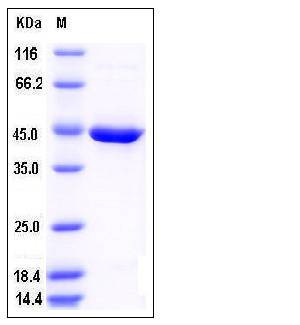Mouse SerpinB10 Protein (His Tag)
9830131G07,BB233602,Serpinb10-ps
- 100ug (NPP3477) Please inquiry
| Catalog Number | P50626-M08B |
|---|---|
| Organism Species | Mouse |
| Host | Baculovirus-Insect Cells |
| Synonyms | 9830131G07,BB233602,Serpinb10-ps |
| Molecular Weight | The recombinant mouse SERPINB10 consists of 408 amino acids and has a calculated molecular mass of 46.5 kDa. It migrates as an approximately 44 kDa band in SDS-PAGE under reducing conditions. |
| predicted N | Met |
| SDS-PAGE |  |
| Purity | > 94 % as determined by SDS-PAGE |
| Protein Construction | A DNA sequence encoding the mouse SERPINB10 (Q8K1K6-1) (Met 1-Pro 397) was expressed, with a C-terminal polyhistidine tag. |
| Bio-activity | |
| Research Area | Immunology |Inflammation / Inflammatory Mediator |Plasma Cascade Systems in Inflammation |Fibrinolysis System |
| Formulation | Lyophilized from sterile 50mM Tris, 100mM NaCl, pH 8.0 1. Normally 5 % - 8 % trehalose, mannitol and 0.01% Tween80 are added as protectants before lyophilization. Specific concentrations are included in the hardcopy of COA. |
| Background | Serpins are the largest and most diverse family of serine protease inhibitors which are involved in a number of fundamental biological processes such as blood coagulation, complement activation, fibrinolysis, angiogenesis, inflammation and tumor suppression and are expressed in a cell-specific manner. Serpins are a group of proteins with similar structures that were first identified as a set of proteins able to inhibit proteases. The acronym serpin was originally coined because many serpins inhibit chymotrypsin-like serine proteases (serine protease inhibitors). Over 1000 serpins have been identified. Mouse SerpinB10, also known as Peptidase inhibitor 10, PI-10, Bomapin and SERPINB10, is a nucleus and cytoplasm protein which belongs to the serpin family and Ov-serpin subfamily. SerpinB10 is expressed specifically in the bone marrow. SerpinB10 is a protease inhibitor that may play a role in the regulation of protease activities during hematopoiesis and apoptosis induced by TNF. SerpinB10 is a redox-sensitive nuclear serpin that augments proliferation or apoptosis of leukaemia cells, depending on growth factors availability. SerpinB10 may regulate protease activities in the cytoplasm and in the nucleus. |
| Reference |
